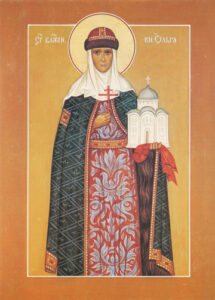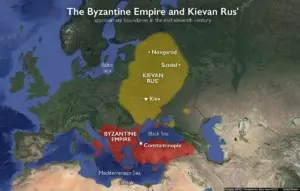
You know I’m compulsive about getting these Posts out every Friday, but I’m two days late this time. I hope this doesn’t disturb the cosmic clock. If the Second Coming is now two days late, you’ll know who to blame.
Introduction
I was originally about to do something foolish here. I’ve done it before. I have sat here at my computer all by myself trying to define the role of women in the Orthodox Church. What do I know about that? I’m not an Orthodox woman. Likewise, when I see a Council of old Orthodox men dealing with women’s issues, a similar thought comes to my mind: Why don’t they have Orthodox women sitting with them, helping them to define their role? I mean, Orthodox women are not stupid.
I’m glad to find, on the website of the Greek Orthodox Archdiocese of America, that there is an organization of women writing on this topic:
Also this article from the OCA, written by a woman: https://www.oca.org/parish-ministry/theology/womens-role-in-the-church-the-perspective-of-a-seminary-graduate-a-mother-a
The Role of Women
So, given my ignorance on the subject, the chief thing I want to do now is have us learn what Orthodox women can do from some female saints, two of whom have feast days during the next two weeks (which is what brought this subject to my mind): July 11 – Saint Olga, Princess of Kiev (or Kyiv, if you prefer), and July 19 – Saint Macrina the Younger. Also just for good measure I’ll throw in (so to speak) her grandmother, Saint Macrina the Elder whom we commemorate on January 14.
But let’s begin with some women closer home.
Advice from some Orthodox women whom I know and trust
1 I think I shared this story with you once before, but I can’t remember when.
Not long after I left the Episcopal Church and became Orthodox, His Eminence Metropolitan Philip (of greatly blessed memory) asked me to represent him at an Episcopalian national Convention. By that time the Episcopalians already had many female priests and had begun ordaining female bishops. I knew I would be asked how I could join a Church which oppressed women by not ordaining them. I wanted to be prepared.
Now, at the time I was the Milwaukee Orthodox Clergy Association’s “chaplain” to the Milwaukee Orthodox Women’s Association – whose governing board was the best-organized, most competent group I’ve ever deal with, bar none. So after one of their meetings I asked them the question: “Has the fact that the Orthodox Church doesn’t ordain women ever been an issue with you?” Almost before I could get it out of my mouth, they without exception answered “No!” Rather startled, I asked “Why not?” Some of their answers: “Who would want that?” “It’s contrary to Church Tradition.” “We already run the Church!” There was no dissent among them.
From that, and from what have I read and experienced elsewhere, I gather that the role of the ordination of women to the “sacramental” priesthood is not a big issue for women in the Orthodox Church. So far as I know, only two notable theologians have even opened the subject: Bishop Kallistos Ware suggested that the ordination of women to the priesthood was “not impossible”, and Elisabeth Behr-Sigel (as I’m told – I haven’t read her) suggested it was possible. However, so far as I can see, there is no significant movement advocating for female priests in the Orthodox Church – nothing remotely like what happened in Anglicanism, or what many are pressing for in the Roman Catholic Church.
2 I also asked for a comment from another intelligent, perceptive, faithful Orthodox woman – in fact, the one sitting across our living room from me even now. Here’s what she wrote: “What is the role of women in the Church?” “What do women want?” is a question often asked, as though ALL women think and feel alike and want the very same thing. What women want–what this woman wants–is to be treated as an individual with gifts and talents to a degree greater or lesser than any other human being. I want to be “seen” as myself, a human being who happens to be female, not pigeon-holed into some preordained ‘role’ into which someone else wishes to place me because I’m ‘female.’ It’s been a learning process for societies and the Church which may never be done, and that’s a good thing, I think, because women of the future may ‘want’ something different – as is their right as individuals created in the image of God.”
Yes. If we asked the question “What is a Man’s Role in the Orthodox Church”, I think we would at first get a surprised look. Who has ever asked that question? And then I’d think we’d get many answers.
Now, the first of three female Orthodox saints, each of whom had quite different roles:
Saint Olga of Kiev (or Kyiv, if you prefer)

Olga, who was of Varangian * origin, was born about the year 890 either in Pskov in the northwest of modern-day Russia or, according to the Russian Chronicles, in Vyshgorod in the north of modern-day Ukraine. (We can see the seeds of today’s conflict arising already.)
- The Varangians were from Sweden – Vikings! Those who headed south were called the ‘Rus’.
At about age 13 Olga was married to Igor I, son of Rurik, Prince of the Kievan ‘Rus who from Kyiv ruled much of today’s Ukraine, Belarus, Russia and Poland.
When Igor was murdered in 945 by the Derevlyanins * (an East Slavonic tribe), the crown Prince Svyatoslav was only three years old, so Olga served as regent until he came of age almost twenty years later.
- If you want to know how to pronounce that, look it up for yourself.
Keep in mind that the ‘Rus, including Princess Olga, were not Christians. They were the same perilous Vikings who ruled by the sword, the “Norsemen” who were so feared in northwest Europe. * Olga is remembered for her revenge against the Derevlyanins. She had good reason for her anger. They had killed her husband by tying him to two flexible trees, and … you don’t really want to hear the rest of this.
- From a British Litany of the times: “From the fury of the Norsemen, good Lord, deliver us.”
Here is now she got even: Their first representatives to her court she had buried alive. News was slow to get back to Derevlyanin headquarters, so they sent more delegates, whom she had boiled alive in a bathhouse. Then she led an army which wiped out the Derevlyanian people, man, woman and child. The few who survived were made slaves. Princess Olga was tough.
She also was a strong and effective ruler of her people, who protected their borders, who ensured a steady income for the state by appointing reliable, honest, hand-chosen officials to carry out the tax collections. She established better and fairer trade with other nations and promoted religious tolerance. If she was ruthless towards her enemies, she was a good regent to her people.

What caused her to take interest in Christianity we don’t know. Perhaps it took place before her visit to Constantinople. No matter, about the year 955 she led a delegation to visit the Byzantine Emperor Constantine VII, ostensibly to establish better trade relations – according to some accounts, accompanied across the Black Sea by a large flotilla of armed ships to make it clear that she was not a “nobody”.
International visits in those days were not “in and out” as they are these days. In the considerable time Olga spent in Constantinople, what she saw drew her to Christian Faith, and she prepared to be Baptized. Constantine came to admire not only her beauty but also her intelligence, telling her “You are fit to reign in this city with us.” Then he asked her to marry him. Taken aback, she asked for time to consider it.
Olga did not want to abandon her people and, still less, to become second-in-command. However, she also did not want to insult this powerful Emperor to the south. So now her cleverness and wit came through. She quickly asked the Emperor to be her sponsor in Baptism. He could hardly say no, lest he insult her, and besides it would look bad in his peoples’ eyes. So he agreed. After she was Baptized, he again asked for her hand in marriage. She replied (this is not an exact quote), “Oh, I’m so sorry. Now I cannot. It is contrary to canon law for a sponsor to marry his god-child”.
Emperor Constantine realized he had been “had”. However, he did not take it badly. He must have been impressed by her “cleverness”, because he sent her home with many fine gifts, and a solid trade treaty with the Empire.
Some say Olga’s “cleverness” was simply a ruse, that she was baptized only so she could escape marrying the guy. However, the evidence shows that it was not. Before she was baptized she studied the Faith diligently. She took on a Baptismal name “Helen”, ἑλένη, Елена. When she returned to Kyiv, she urged her son Prince Svyatoslav to be baptized and become a Christian. He never did, but she convinced him always to tolerate Christians, even after her death.
Princess Olga died on July 11, 969. Even though she was gone, her son Prince Svyatoslav allowed an Orthodox priest to give her a Christian burial.
Saint Olga is honored for bringing Christianity to the ‘Rus. Why? She certainly appeared to have no success at that during her lifetime. However, yes she did. Svyatoslav gave her grandson Vladimir a traditional pagan upbringing, but for some reason he became dissatisfied with that and desired more. Had he seen something deeper and greater in his grandmother’s faith?
You likely know the story of how Prince Vladimir, when he came to power, sent delegations to the various religions of the known world to “research” them for him. Finally after visiting Constantinople and the great church Hagia Sophia, they returned reporting “We didn’t know if we were in Heaven or on earth… We cannot forget that beauty.” That was it. “Primed” for this by his grandmother Olga, Vladimir was baptized, and at his command so were all the ‘Rus. He brought priests innumerable from Constantinople, built many churches, and Ukraine, Russia and Belarus have been solidly Orthodox Christian ever since. That is why, about six hundred years later, Princess Olga of Kyiv was officially given the title Saint Olga, Equal to the Apostles.

Saint Olga’s peoples’ religious faith has been strong like her, with an inner power which allowed them to survive the Mongols and Nazis and even seventy years of atheistic Communism, with its systematic persecutions. At one time in the 1930s it was estimated that in all Russia only three Orthodox bishops were still “at their practice”, and one of them was suspected of being a Communist dupe. All the others were either dead or in prison.
That allows us to hope that her people can survive the present Orthodox catastrophe: For the first time in history, the Orthodox ‘Rus are at war with each other – the greatest nation of the ‘Rus (145 million people) waging war on their much lesser neighbor (45 million) to the south. Percentage-wise, Ukraine has more Orthodox (78%) than Russia (71%). And Ukraine is not allowed to fight back. This is not a fair fight!
Saint Olga, Equal to the Apostles, pray for your people!
________________________________
I can’t resist adding this, though it’s not directly relevant:
“And I will say one thing – Russia has never been and will never be ”anti-Ukraine“. And what Ukraine will be – it is up to its citizens to decide.” Last lines of a long article by Vladimir Putin ”On the Historical Unity of Russians and Ukrainians“, July 12, 2021 http://en.kremlin.ru/events/president/news/66181
_________________________________
After all that, it’s almost hard to remember what this Post is all about.

Saint Olga’s model of a Role for Women
Keep in mind that each human being is unique. Each Orthodox woman plays a slightly different part.
As regent Olga at first had a very public ministry, then later accepted a hidden one.
She was strong: not afraid of power and its exercise – sometimes for evil in her pre-Christian years, but for also good even before her conversion.
She was intelligent, devout, clever.
She was effective in bringing the Faith to her people – though only through a grandchild after her death. She never lived to see the fruits of her labors.
Have I missed any characteristics?
Next Week: The Role of Women, Part Two – Saint Macrina the Elder, Saint Macrina the Younger
Week after next: Various things
Sources of this article
https://explorethearchive.com/olga-of-kiev
https://obitel-minsk.org/en/saint-olga-and-vladimir-the-great?gclid=Cj0KCQjwho-lBhC_ARIsAMpgMoeh8vONPR1-d33JUFeksCHt5Pw_GRAThG0W1M6LPxBNukej4-oUOUwaAii9EALw_wcB.
https://www.britannica.com/biography/Saint-Olga
https://orthodoxwiki.org/Olga_of_Kiev
https://www.oca.org/saints/lives/2021/07/11/102003-equal-to-the-apostles-blessed-great-princess-olga-in-holy-baptis
This is a most welcomed post, Father Bill. Thank you very much for this important history.